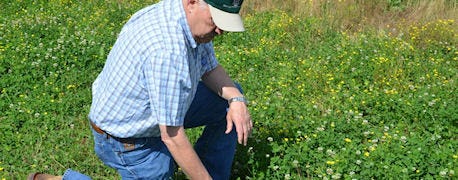June 18, 2014

A new white clover developed in East Texas for conditions in the Southeast US is coming available this fall.
Texas A&M researchers say they developed the new white clover, named Neches after the Texas river, to produce higher yields and much earlier flowering and seed production than any previously released variety adapted to East Texas and the southeastern US.
Barenbrug seeds has the rights of distribution and is planning to offer the clovers for planting this fall.
"We're very excited about this clover because it combines a lot of traits that just fit for our area," says Gerald Smith, the Texas A&M plant breeder who developed the variety at the Overton research station.

Early, high seed production means a Neches white clover stand has a good chance of returning yearly, even if plants are killed by summer heat or drought, says Texas A
Like other white clovers, Neches does well on the wet, loamy bottomland soils of East Texas, Smith says. However, other white clovers do not flower profusely and therefore do not produce much seed until at least early to midsummer. In East Texas, midsummers are usually hot and dry, and white clover stands are likely to die out before they can produce seed.
Smith says this means traditional white clovers in bottomlands must be reseeded every year to re-establish the stand -- an expensive proposition.
Smith's goal, then, was to develop a variety at least as productive and with as much disease and pest resistance as existing varieties, but which would flower and produce seed before the stand was lost to summer heat.
~~~PAGE_BREAK_HERE~~~
Smith says in early June it was obvious Neches fills that bill. In side-by-side demonstration fields of Neches and a ladino white clover, the difference in flowering was obvious. While Barblanca, the ladino clover, had one or two flowering seedheads per square foot, Neches had 20 to 30 seedheads per square foot.
Smith also selected for larger leaves, which means high forage yields.
Neches' advantages didn't come easily. They are the result of years of meticulous crossings and selection of the right plant parent lines that began in 2000.
"The parent lines of Neches are highly diverse, including plant introduction lines from Uruguay and Israel, an East-Texas-ecotype collection and two pest-resistant lines from USDA at Mississippi State University," Smith said.
From 2000 through 2004, Smith screened each of these five breeding populations at Overton for early and profuse flowering, large leaf size and high forage production potential, he said.
"Plants not selected were removed from the field planting," Smith said. "All field nurseries were isolated from other white clover plants and natural bee pollination was used for seed production."
In 2005, Smith grew 200 plants from each of the five advanced populations in a combined nursery and selected once again for the same traits, he said. Seed harvested from these final selections was used as breeder seed for Neches.
A study on grazing and daily gains with cattle is currently being done as a cooperative project with Monte Rouquette, another Overton researcher.
Barenbrug USA was granted an exclusive license to market Neches in 2011, and has been increasing the seed at sites in Oregon and California, Smith says.
"Neches should be available this fall anywhere Barenbrug seed is sold," Smith adds.
You May Also Like




